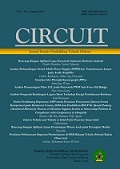Optimalisasi Metode Electroplatting Koagulasi Terhadap Penurunan Kadar Logam Zinkum (Zn) Pada Air Buangan Limbah Industri Pengolahan Karet
DOI:
https://doi.org/10.22373/crc.v1i1.312Keywords:
electroplatting, koagulasi, zinkum, limbah, industri karetAbstract
Penelitian tentang penggunaan metode electroplatting koagulasi untuk menurunkan konsentrasi logam Zn dalam air limbah industri karet telah dilakukan. Limbah yang digunakan memiliki karakteristik kontaminan Zn 1.2771 mg/L. Percobaan dilakukan dengan tegangan listrik 12 Volt, kuat arus 10 A, variasi waktu 0, 15, 30, 45, sampai 60 menit, variasi pH limbah 4, 7,dan 8, karakteristik plat elektroda dengan panjang 10 cm, lebar 2 cm dan ketebalan 0,5 mm, serta volume sampel sebanyak 1 liter dalam keadaan statis. Analisis Zn pada hasil akhir digunakan Spektrofotometer Serapan Atom (SSA). Hasil penelitian menunjukkan penurunan konsentrasi logam Zn pada pH 7 dengan waktu kontak 60 menit, yakni sebesar 99,56 %. Kata Kunci: electroplatting, koagulasi, zinkum, limbah, industri karet.Downloads
Published
2015-09-02
Issue
Section
Articles
License
Authors who publish in CIRCUIT: Jurnal Ilmiah Pendidikan Teknik Elektro agree to the following terms:
- Authors retain copyright and grant the journal right of first publication with the work licensed under a Creative Commons Attribution-ShareAlike 4.0 International License (CC BY-SA 4.0) that allows others to share and adapt the work with an acknowledgement of the authorship and initial publication in this journal
- Authors are able to enter into separate, additional contractual arrangements for the non-exclusive distribution of the journal's published version of the work (e.g., post it to an institutional repository or publish it in a book), with an acknowledgment of its initial publication in this journal.
- Authors are permitted and encouraged to post their work online (e.g., in institutional repositories or on their website) prior to and during the submission process, as it can lead to productive exchanges, as well as earlier and greater citation of published work. (See The Effect of Open Acces)

